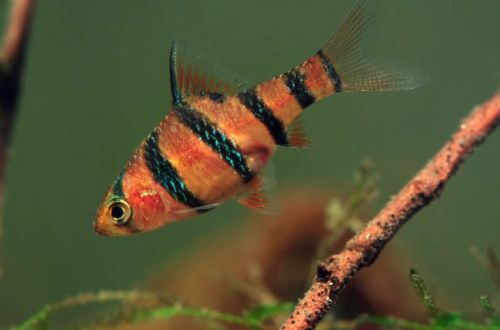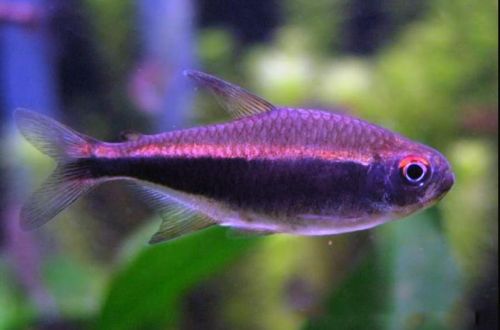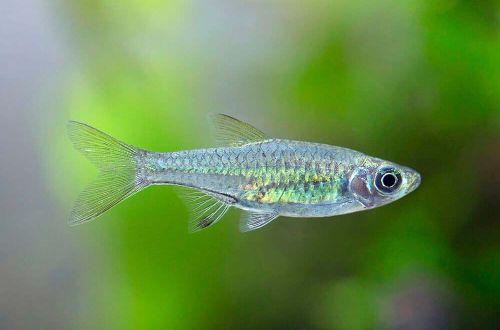
Five-striped Barbus
The five-banded barb, scientific name Desmopuntius pentazona, belongs to the Cyprinidae family. Beautiful mobile fish, easy enough to keep, provided that the aquarium is properly configured and the composition of the water meets the requirements. The specimens supplied for sale are, as a rule, grown in the artificial environment of commercial nurseries and are perfectly acclimatized.

Contents
Habitat
Endemic to the island of Borneo, in Southeast Asia, the territory of modern Malaysia. It is found in peat bogs and streams and rivers flowing / flowing from them. The habitat is characterized by rich aquatic and coastal vegetation, the water has a rich tea color due to the high concentration of humic acids and other chemicals resulting from the decomposition of plant organic matter. The substrate is usually littered with numerous fallen leaves, branches and underwater roots of trees.
Brief information:
- The volume of the aquarium – from 80 liters.
- Temperature – 21-26°C
- Value pH — 4.0–7.0
- Water hardness – soft (1-5 dGH)
- Substrate type – any soft
- Lighting – subdued
- Brackish water – no
- Water movement – weak current or still water
- The size of the fish is up to 5 cm.
- Food – any food
- Temperament – peaceful calm fish
- Keeping in a flock of 10 individuals
Description
Adults reach a length of about 5 cm, while females are somewhat larger, males look slimmer and even more elegant, and also have a more saturated body color. The main color is copper-red, the pattern consists of five dark stripes that cross the body vertically. The first stripe passes through the eye, and the last is closer to the base of the caudal fin. There is another closely related species that has an almost identical body pattern – the Six-banded Barb.
Food
Accepts all types of dry, frozen and live foods of suitable size. A varied diet enhances the color of the fish. Feed 2-3 times a day in the amount eaten in five minutes. Feed residues should be removed in a timely manner to avoid unnecessary contamination of the water.
Maintenance and care, arrangement of the aquarium
A flock of Five-Striped Barbs for a comfortable life will require a tank of 80 liters or more, similar in design and conditions to their natural habitat. The design uses a soft peat-based substrate, a large amount of aquatic vegetation, including floating plants, numerous shelters made of snags, branches or tree roots. At the bottom, pre-dried and then soaked in water (to drown) leaves are placed, which, in the process of decomposition, will give the water a natural tea shade. A similar effect can be achieved if a woven bag filled with prepared peat is placed in the aquarium, the latter is purchased exclusively at a pet store. As a step-by-step guide to decorating an aquarium, the article “How to create a biotope of river systems in Southeast Asia” is useful.
The set of equipment is standard and includes a filtration system, a heater, an aerator and low power lighting lamps. As a filter material, it is desirable to use peat-based materials.
The water conditions are characterized by the absence of an internal current, a slightly acidic pH value with a low concentration of dissolved calcium and magnesium salts (parameter dGH).
Maintenance is reduced to a weekly replacement of part of the water (about 10% of the volume) with fresh, regular cleaning of the soil from organic waste and glass from plaque.
Behavior and Compatibility
Peaceful relatively calm fish. Keeping a flock, a group of 8-10 individuals makes the Five-striped Barb less shy and allows males to show their best color in the fight for the attention of females. Compatible with most species similar in size and temperament. It is worth avoiding the sharing of noisy or too active neighbors.
Breeding / breeding
Refers to spawning species, females scatter eggs in the water column, and males at this moment fertilize it. Parental instincts are poorly developed, immediately after spawning, the fish can eat their own caviar and fry that have appeared.
Breeding is recommended to be carried out in a separate tank – a spawning aquarium, in order to protect offspring from adult fish. The design is simple, the main attention is paid to the ground, it should consist of particles of a sufficiently large size that do not fit tightly to each other, forming voids, for example, pebbles or decorative glass beads. When the eggs sink to the bottom, most of them fall into these voids and thus become inaccessible to fish. A similar effect is also achieved when using a fine mesh, which is fixed at the bottom.
Another way to ensure the preservation of eggs is to use low-growing small-leaved plants or mosses such as Riccia floating and Javanese moss, which are planted on most of the surface of the substrate (in this case, the soil can be any). Dense thickets of plants can provide reliable shelter for eggs no worse than special soil.
The size of the spawning aquarium is usually 20-30 liters. The equipment used is an aerator, a heater and a simple sponge filter of low power to prevent accidental suction of eggs and fry. Spawning occurs in dim light, so at first there is no need for a light source.
The beginning of the mating season will be marked by the fact that the females become noticeably rounder, and the males will begin to actively show signs of attention to their chosen ones. At this point, you should prepare a separate tank and fill it with water from the general aquarium, then transplant several females and the most colorful males there. The easiest way to determine its ending is by females – they will become slender.
The fish are returned. The fry will appear in 24-48 hours, and after another 3-4 days they will begin to swim freely. Feed with specialized microscopic food for juvenile aquarium fish.
Fish diseases
A balanced diet and suitable living conditions are the best guarantee against the occurrence of diseases in freshwater fish, so if the first symptoms of an illness appear (discoloration, behavior), the first thing to do is check the condition and quality of the water, if necessary, return all values to normal, and only then do treatment. Read more about symptoms and treatments in the Aquarium Fish Diseases section.





